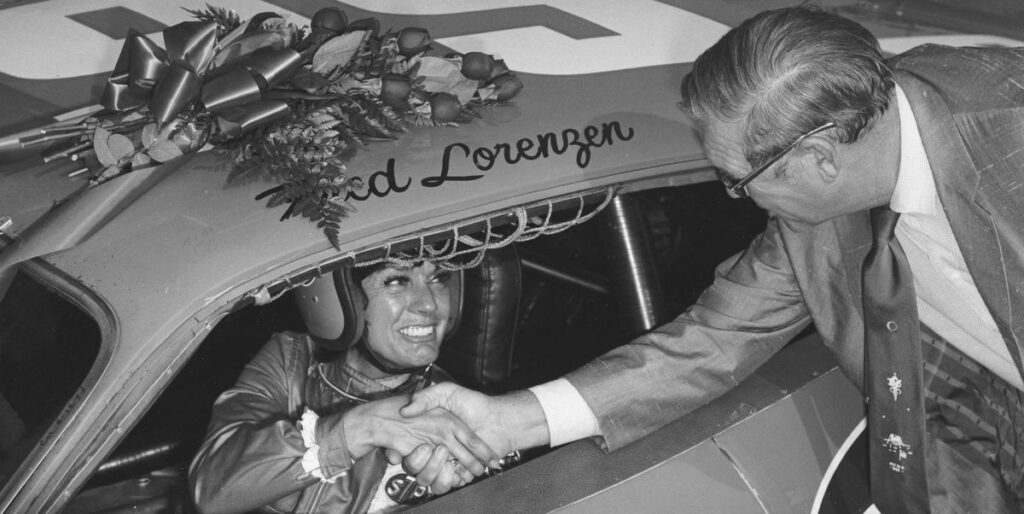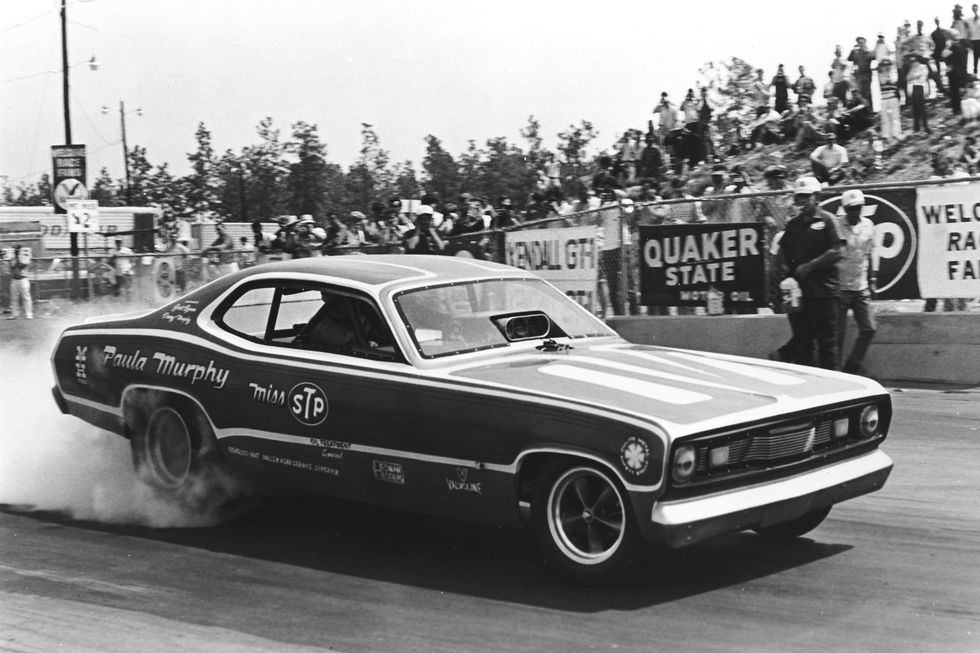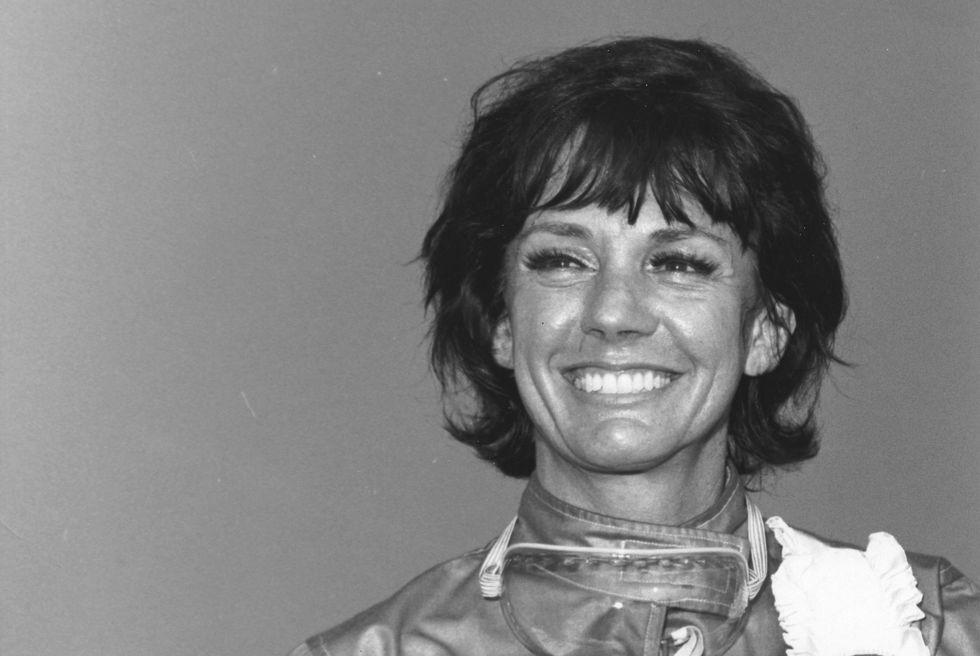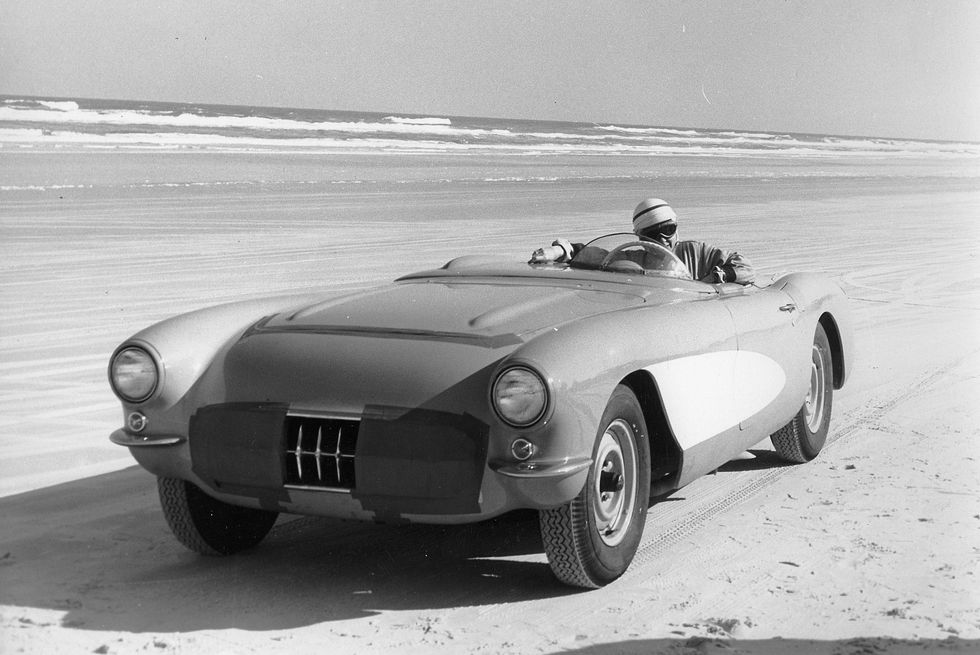STP Racer Paula Murphy (Finally) Celebrated in a New Documentary

A few days before the debut of a documentary about her life, 95-year-old Paula Murphy broke her leg. Most of us, even without the excuse of age, would send our polite regrets about missing the party, and sit at home with a nice book and some painkillers. Heck, that’s my preferred evening activity without a broken leg.
Murphy, though, is not most of us. She showed up at the Petersen Automotive Museum dressed to impress in green satin, her leg in a cast but her toenails neatly painted.
Paula Murphy didn’t let a broken leg stop her from attending the premiere of the documentary about her life. At age 95, she answered questions, signed autographs, and told stories of her days behind the wheel.
Car and Driver
This is a woman who used to sit on a small pillow to reach the pedals in a jet-powered land-speed car. She drove a Petty stock car and a Novi Indy car, both with minimal prep and at well over 100 mph. She survived a crash in a rocket-powered dragster at nearly 300 mph and didn’t let it stop her from getting back into road racing in a Datsun, and later a Honda Civic.
Murphy could drive anything. A little tumble and a cracked fibula weren’t going to keep her home. Not for nothing was the film titled Paula Murphy: Undaunted.

RacingOne|Getty Images
Undaunted is the latest in the “Left Behind” series of films by Pam Miller and Cindy Sisson. The team started with a documentary in 2022 about the air and auto racer Betty Skelton. Their aim is to tell the stories of women trailblazers in motorsports, particularly those who may not have received the accolades that they deserved during or following their careers. I was familiar with some of Paula’s story, primarily on the drag-racing side, but she did so much more than I had ever heard about. I guess that’s sort of the point of the series. It’s a great film, full of crisp vintage footage from the salt flats and circle tracks interspersed with modern-day interviews.

RacingOne|Getty Images
A bonus is Murphy’s million-dollar smile, which shows up every time she tightens her helmet and climbs in a car. She unleashed that smile, undimmed by age, on the audience during a standing ovation after the film and declared it absolutely worth leaving the house for. I have to agree.
This content is imported from youTube. You may be able to find the same content in another format, or you may be able to find more information, at their web site.
Director Pam Miller Explains the Series
I had a chance to speak with director Pam Miller about the Left Behind series and how she became a producer in motorsports coverage—an industry still mostly male, even in 2023. Miller has been producing sports coverage for nearly three decades, with credits ranging from Formula 1 to dirt tracks on networks including CBS, NBC, and ESPN. She’s currently the coordinating producer for Fox’s NASCAR coverage, and she knocks out documentaries in between races.

Betty Skelton behind the wheel of a Corvette on Daytona Beach.
RacingOne|Car and Driver
Car and Driver: Was Boundless: Betty Skelton your first documentary film?
Pam Miller: No, I’ve been doing documentaries for Fox on and off for the past 10 years. This current batch started about three years ago. I was one of the producers on Blink of an Eye, about the 2001 Daytona 500, when Michael Waltrip wins the race and loses his best friend [Dale Earnhardt] 15 seconds later. That was 2019. Then during the pandemic, my friend Cindy Sisson was starting her Women in Motorsports events and I said, “Oh, I have this whole list of women [who would be good stories],” and we started brainstorming how we might make those films. We invited the vice president of studio shows for Fox to come by and talk with us one day and we pitched her on Betty Skelton, and she loved it. We took her for a ride in a Ferrari, too, which didn’t hurt.
Betty, Paula; who else is on the list?
So many! Even women whom you’ve heard of, say, Shirley Muldowney, their story doesn’t always get told the way it should be. I can tell you we have a list of women from motorsports, the auto industry, even aviation, and their stories need to be told. Some are crazy stories, some are outlandish, and some are just mind-blowing. And we wouldn’t be here without them.
On that note, was this something that you always wanted to do? How did you become a motorsports producer?
I didn’t know, growing up, what it was called. I just know that I was constantly writing scripts and short stories. I was organizing. I would put on talent shows with my brother, sister, and neighborhood kids. So once I figured out it was producing, I went to school for it, and my first assignment was in sports, not racing.
When did the racing interest start?
My first assignments at ESPN were NFL and NHL, because that’s what I had been working on out of school. I was there for maybe six months, and I went on vacation. I came back, and the NHL had given the rights to the next three years to a different network. Terry Lingner, who was my coordinating producer on the NHL, was also the coordinating producer for auto racing, Terry told me that he knew I wanted to be a producer at the big games, but he thought there would be more opportunities for me in auto racing. I said, “I don’t even know where the oil goes in my car,” and he said, “We’ll figure it out.” I ended up loving it and traveling the world producing Formula 1, NASCAR, IndyCar, whatever property they had that week.
What’s different about doing these historical pieces as compared to the race productions or interviews with active competitors?
You can do an interview with somebody at one phase of their career where they’re not so willing to open up. Then ten years later they’re willing to tell their story. I’m looking around my office right now at pictures of Mario and Dale, Jeff Gordon, and those guys had reason to be reserved at times because of their sponsors, but over time they’ve lightened up and let slip with little things that make them even more interesting.
Tell me about the process for the documentaries. How do you track down these lost stories?
I do a ton of reading and then it’s almost a whiteboard process. What is the reach of this person? Who are they connected with? Who did they work with? If they’re the center of the universe, where do all the roads go off of them? I kind of use that as my skeleton of the journey and use interviews to start filling in the skeleton.
Once you start getting to know the person and learning more about them, there’s always something cool that’s hidden, so I try not to get pigeonholed by the outline or the skeleton of the story. I try to see where it leads me.

Senior Editor, Features
Like a sleeper agent activated late in the game, Elana Scherr didn’t know her calling at a young age. Like many girls, she planned to be a vet-astronaut-artist, and came closest to that last one by attending UCLA art school. She painted images of cars, but did not own one. Elana reluctantly got a driver’s license at age 21 and discovered that she not only loved cars and wanted to drive them, but that other people loved cars and wanted to read about them, which meant somebody had to write about them. Since receiving activation codes, Elana has written for numerous car magazines and websites, covering classics, car culture, technology, motorsports, and new-car reviews.



